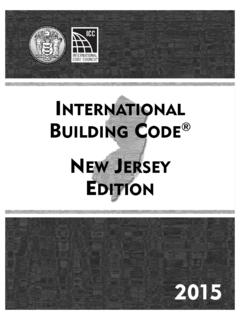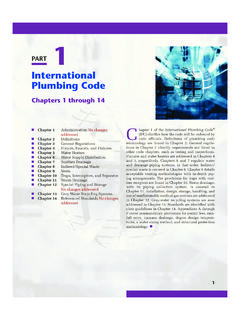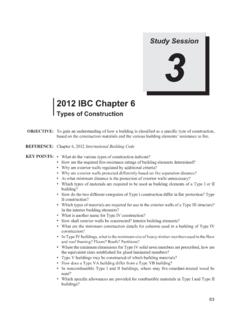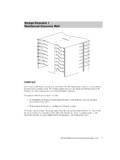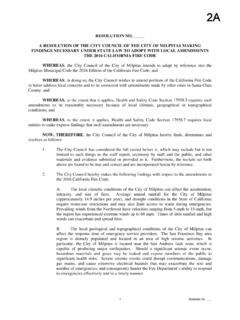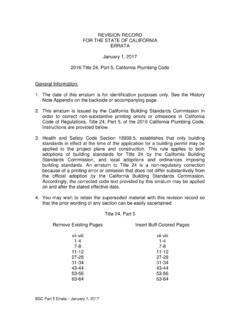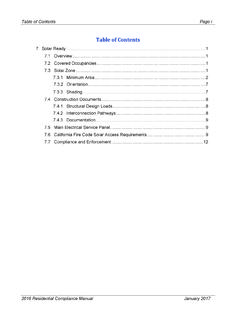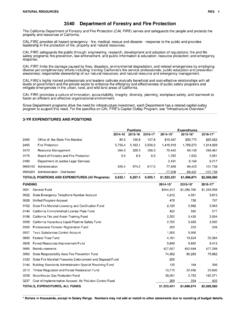Transcription of SIGNIFICANT CHANGES TO THE CALIFORNIA BUILDING CODE
1 SIGNIFICANT CHANGES TO THECALIFORNIA BUILDING CODE2013 i8/16/2013 10:23:02 AM8/16/2013 10:23:02 AMPART 1 AdministrationChapters 1 and 2 1 , and Final Inspections 2 202 Defi nitions Group I-3 Occupancies 3 PART 2 BUILDING PlanningChapters 3 through 6 6 Rooms Associated with Group E Occupancies 8 Classifi cation of Casino Gaming Floors 10 , Classifi cation of Commercial Kitchens 12 Table (1), Section Generating Combustible Dusts 14 Group I-3 Occupancies 15 , Buildings Fire and Smoke Protection 17 Buildings Fire Service Access Elevators 21 Parking Garages 23 Parking Garages Openings below Grade 25 407, 408 Group I-3 Occupancies 27 , 202 Technical Production Areas 34 Hangar Fire Areas 37 Waste Management for Group R Occupancies 39 Height and Area Limitations Solar Photovoltaic System 40 Means of Egress 42 Area Buildings Accessory Occupancies 44 509 Incidental Uses General Provisions 46 509 Incidental Uses Separation and Protection iii8/16/2013 10:23:03 AM8/16/2013 10:23.
2 03 AMiv CONTENTS Table 509 Incidental Uses Rooms or Areas 50 Rating Requirements for Solar Photovoltaic Systems 52 PART 3 Fire Protection Chapters 7 through 9 54 Fire Assemblies 56 Fire-Resistance Ratings 58 cation of Fire and Smoke Separation Walls 59 of Projections beyond Exterior Walls 61 Graphics on Exterior Walls of High-Rise Buildings 63 Fire Walls 65 , of Fire Barriers at Roof Assemblies 67 712 Vertical Openings 69 Penetrations of Horizontal Assemblies 71 of Horizontal Assemblies 73 Curtain Wall/Floor Intersection 75 Table Protection Ratings and Markings 77 in Exit Enclosure and Exit Passageway Doors 80 Table Glazing 82 Glass in Fire Window Assemblies 84 Damper Exemption for Fire Partitions 86 in AmbulatoryCare Facilities 88 , , Storage and Display in Group F-1, M, and S-1 Occupancies 90.
3 Protection Systems in Group I-3 Occupancies 92 Protection for Basements 96 Exemption for Solar Photovoltaic Systems 98 Water Supply 100 of Multiple Fire-Extinguishing Systems 102 Fire Extinguishers in Group R-2 Occupancies 104 Voice/Alarm Communication Captions 105 Detection in Group R-2 College Buildings 107 , Alarms for Group R-2, , R-3, , R-4 and I-1 110 Alarm Systems for High-Rise Buildings 112 Command Center Ventilation in High-Rise Buildings 114 Pump Fuel Supply in High-Rise Buildings iv8/16/2013 10:23:03 AM8/16/2013 10:23:03 AMCONTENTS vPART 4 Means of EgressChapter 10 116 Occupant Loads 118 , Table Occupant Load Areas without Fixed Seating 119 1005 Means of Egress Capacity Determination 121 Egress Locks for Courtrooms 125 Locked Egress Doors 126 Elevator Lobby Doors in High-Rise Offi ce Buildings 128 1009, 1010, 202 Interior Stairways and Ramps 130 of Stairway Provisions 134 , at Operable Windows 135.
4 Of Egress for Group I-3 Occupancies 138 or Exit Access Doorway Arrangement 141 Penetrations of Interior Exit Stairways 142 of Spaces under Grandstands and Bleachers 144 PART 5 AccessibilityChapter 11 145 Chapter 11 AHousing Accessibility 146 Chapter 11 BAccessibility 147 PART 6 BUILDING Envelope, Structural Systems, and Construction MaterialsChapters 12 through 26 148 Ventilation 150 Ventilation of Bathrooms 152 1207 Sound Transmission 153 1212 Pollutant Control 154 Gardens and Landscaped Roofs 155 , 202 Photovoltaic Systems 157 1509, 202 Rooftop Structures 159 Table ection Limits 166 , 202 Risk Categories 167 Combinations Using Strength Design of Load and Resistance Factor Design 170 Combinations Using Allowable Stress Design 172 Table Live Loads 175 Vehicle Loads 179 1609, 202 Determination of Wind Loads 181 , 202 Mapped Acceleration Parameters 191 Photovoltaic System 197 of Special Inspections 199 Inspection of Steel Construction v8/16/2013 10:23:03 AM8/16/2013 10:23.
5 03 AM Table Verifi cation and Inspection of Concrete Construction 207 Inspection of Masonry Construction 209 Inspection of Fire-Resistant Penetration and Joint Systems 211 Reports for Foundation Walls and Retaining Walls 212 Chapter 19 Concrete Construction 213 Detailing of Wall Piers 217 Methods for Masonry Structures 219 2206 Composite Structural Steel and Concrete Structures 220 Requirements for Cold-Formed Steel Structures 222 2305 General Design Requirements for Lateral-Force-Resisting Systems 224 2306 Allowable Stress Design 226 2307 Load and Resistance Factor Design 230 , Glazing Hazardous Locations 232 Glazing Impact Test 238 Barriers for Stucco Applications 240 , Approval of Foam Plastics 242 PART 7 BUILDING Services, Special Devices, and Special ConditionsChapters 27 through 34 244 3007 Fire Service Access Elevators 245 3008 Occupant Evacuation Elevators 250 3111 Solar Photovoltaic Panels/Modules 254 Appendix LEarthquake-Recording Instruments 258 Appendix MTsunami-Generated Flood Hazards 260vi vi8/16/2013 10:23:04 AM8/16/2013 10:23.
6 04 AMThe purpose of Signifi cant CHANGES to the CALIFORNIA BUILDING code 2013 Edition is to familiarize BUILDING offi cials, fi re offi cials, plans examiners, inspectors, design professionals, contractors, and oth-ers in the construction industry with many of the important CHANGES in the 2013 CALIFORNIA BUILDING code (CBC). This publication is designed to assist those code users in identifying the specifi c code CHANGES that have occurred and, more important, understanding the reason behind the change. It is also a valuable resource for jurisdictions in their code adop-tion a portion of the total number of code CHANGES to the CBC are discussed in this book. The CHANGES selected were identifi ed for a number of reasons, including their frequency of application, special signifi cance, or change in application.
7 However, the importance of those CHANGES not included is not to be diminished. The 2012 International BUILDING code (IBC ) is the basis for the CBC. Further information on all code CHANGES can be found in the code CHANGES Resource Collection, available from the International code Council (ICC ). The resource collection provides the published documentation for each successful code change contained in the 2012 IBC since the 2009 book is organized into seven general categories, each represent-ing a distinct grouping of code topics. It is arranged to follow the general layout of the CBC, including code sections and section number format. The table of contents, in addition to providing guidance in use of this publication, allows for quick identifi cation of those signifi cant code CHANGES that occur in the 2013 the book, each change is accompanied by a photograph, an application example, or an illustration to assist and enhance the read-er s understanding of the specifi c change.
8 A summary and a discussion of the signifi cance of the CHANGES are also provided. Each code change is identifi ed by type, be it an addition, modifi cation, clarifi cation, or dele-tion. The code change itself is presented in a format similar to the style utilized for code -change proposals. Deleted code language is shown with a strike-through, whereas new code text is indicated by underlining. As a result, the actual 2013 code language is provided, as well as a comparison with the 2010 language, so the user can easily determine CHANGES to the specifi c code with any code -change text, Signifi cant CHANGES to the CALIFORNIA BUILDING code 2013 Edition is best used as a study companion to the 2013 CBC. Because only a limited discussion of each change is provided, the code itself should always be referenced in order to gain a more vii8/16/2013 10:23:04 AM8/16/2013 10:23:04 AMhensive understanding of the code change and its application.
9 The com-mentary and opinions set forth in this text are those of the authors and do not necessarily represent the offi cial position of the ICC. In addition, they may not represent the views of any enforcing agency, as such agencies have the sole authority to render interpretations of the CBC. In many cases, the explanatory material is derived from the reasoning expressed by the code -change concerning this publication are encouraged and may be directed to the ICC at signifi the CALIFORNIA BUILDING code BUILDING offi cials, design professionals, and others involved in the build-ing construction industry recognize the need for a modern, up-to-date BUILDING code addressing the design, construction and installation of BUILDING systems through requirements emphasizing performance.
10 The International BUILDING code (IBC), 2012 edition, is the basis for the 2013 CALIFORNIA BUILDING code (CBC) and is intended to meet these needs through model code regulations that safeguard the public health and safety in all communities, large and small. The IBC is kept up to date through the open code -development process of the International code Council (ICC). The provisions of the 2009 edition, along with those code CHANGES approved through 2010, make up the 2012 edition. The ICC, pub-lisher of the IBC, was established in 1994 as a nonprofi t organization ded-icated to developing, maintaining, and supporting a single set of comprehensive and coordinated national model BUILDING construction codes.

